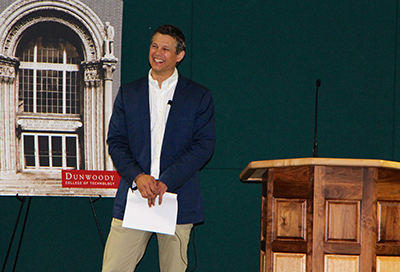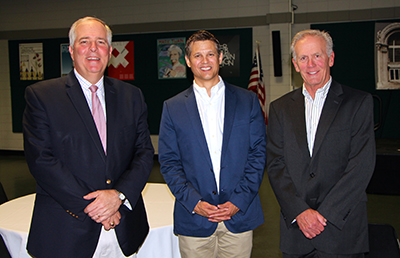Taking Shelter: Building Disaster Resistant Shelters with FABCON Precast Wall Panels
Two of the most devastating natural disasters, hurricanes and tornadoes, occur in the United States. Every year they cause thousands of injuries, fatalities, extensive property damage and loss. Tornadoes are especially devastating in a distinct region of the US dubbed Tornado Alley, which stretches from Texas to Minnesota and across Oklahoma, Kansas, Iowa, and Nebraska.
Between 1950 and 2011, tornadoes resulted in approximately 5,600 deaths in the US, more than both hurricanes and earthquakes combined during the same time period. The deadliest year for tornadoes was 2011, when 553 people lost their lives during tornadoes. The tornado with the greatest number of fatalities on record occurred in Joplin, MO, on May 22, 2011, with 161 fatalities.
![US Tornado Activity Map]()
Where Tornadoes Happen
According to the National Climatic Data Center, tornadoes can happen any time of year, anywhere in the US, so there isn’t an official tornado season like there is with Atlantic hurricanes. However, a higher percentage of tornadoes occur during spring and midsummer throughout a multi-state region called Tornado Alley, which consists of areas in northern Texas, Oklahoma, Kansas, Iowa, Nebraska and southern Minnesota.
The reason this part of the country is more prone to tornadoes is because it is perfectly positioned for the formation of super-cell thunderstorms, which often produce EF-2 or greater tornadoes (the most violent). Most early spring tornadoes happen in the southeast and south central regions. Tornadoes that happen between February and April tend to occur in the Gulf States, such as Mississippi and Louisiana.
Tornadoes in late spring usually hit farther north into Kansas, Nebraska and Tennessee. By the middle of summer, Tornado Alley is active. During this time, tornadoes can show up anywhere in the United States. The end of summer can bring stronger tornados to the upper Midwest and Ohio valleys, with the pattern reversing in late fall. Winter is an unlikely time for a tornado but deadly tornados have happened during this time, so it’s important to be prepared.
Protecting Against Disaster
Sadly, many of the injuries and fatalities of these storms could have been prevented with better evacuation procedures and access to disaster resistant storm shelters, safe rooms and refuges. For example, a community shelteris intended to provide protection for a large number of people, from as few as 12 to as many as several hundred people. These shelters include public shelters and private shelters for businesses and other organizations. Increasingly, community shelters are being built on existing structures such as school auditoriums.
FEMA has developed a set of hazard-resistant codes and standards for assessing how structures respond in a disaster, including the Standard for the Design and Construction of Storm Shelters, known as ICC 500. The purpose of this standard is to establish minimum requirements for the design, construction, and installation of storm shelters constructed for protection from high winds associated with tornadoes and hurricanes. Adoption of these standards can help save lives.
Shelters vs. Conventional Structures
Windborne debris, also referred to as “missiles”, cause many of the injuries and damage from tornadoes and hurricanes. In conventional buildings, windows and glazing in exterior doors are not required to resist windborne debris, except for buildings in windborne debris regions.
In most cases, non-shelter buildings are designed to withstand wind speeds typical for the area based on historical data. For example, the highest design wind speed in conventional construction can be found in coastal areas along the Atlantic and Gulf Coasts where building designs are for winds in the range of 140–150 mph, 3-second gust in most locations. The FEMA recommended design wind speed for shelters in these same areas is 200–250 mph, 3-second gust. According to FEMA, this standard provides “near-absolute protection.”
Wind pressures are calculated as a function of the square of the design wind speed. As a result, the structural systems of a shelter are designed for forces up to three times higher than those used for typical building construction. Consequently, the structural systems of a shelter (and the connections between them) are very robust. (FEMA 2007)
Design Criteria for Different Types of Shelters
![Shelter Design Criteria]()
Shelters provide different levels of protection depending upon the design criteria used to build them. How much protection the structure provides depends on the design wind speed and the resulting wind pressure, as well as the windborne debris load criteria.
Design wind speed and wind pressure criteria: Wind pressure criteria specify how strong a shelter must be. The design wind speed is the major factor in determining the magnitude of the wind pressure that the building is designed to withstand.
In FEMA’s shelter publications, recommended design wind speeds range from 160 to 250 mph. The 2006 International Residential Code and the 2006 International Building Code, which establish the minimum requirements for residential and other building construction, include design wind speeds ranging from 90 to 150 mph throughout most of the country. (FEMA 2007)
Building Structure Safety Level
FEMA Safe Rooms
![Safe Room]()
A safe room is an interior room, a space within a building, or an entirely separate building, designed and constructed to provide near absolute life-safety from tornadoes or hurricanes. If FEMA funds are used to build the safe room, it must meet the criteria outlined in ICC 500.
ICC Storm Shelters
![Residents sift through debris to find belongings.]()
Storm shelters provide life-safety protection, designed and constructed to meet ICC 500 criteria.
Best Available Refuge Area
These are areas within in an existing building that have been approved by a registered design professional to be least vulnerable to tornado damage. The building may or may not have been originally built to code. Because these buildings are not built to meet ICC 500 criteria, they may not provide life-protection to its occupants but they do provide a better chance for protection than in other areas of the building or outside.
You can learn more about refuge areas in FEMA publication P-431, Tornado Protection: Selecting Refuge Areas in Buildings.
New Construction vs. Retrofit
The easiest and more budget conscious way to construct a safe room or shelter is to include it in a new building. According to FEMA, the cost to retrofit safe rooms in FEMA-funded projects in the Midwest and southeast, cost 10-15 percent more than designing and constructing a safe room in a new building.
For large new building projects, the increase in cost for adding a safe room is negligible.
Many safe rooms constructed as part of a new school, each protecting 200-300 occupants, have added only 1- 2 percent to the total project cost when the safe room was included in the design process from the beginning of the project.|
Risk Assessment
Unless safe room installation is required by the building code or the authority having jurisdiction (AHJ), your safe room or shelter planning should begin with a risk assessment.
FEMA recommends a comprehensive risk assessment that includes:
- Type of extreme-wind hazard (tornado, hurricane or both)
- Threat or probability and potential severity of the hazard based on historic occurrences
- Vulnerability of the building or buildings in the community intended to be served by a community safe room
- Size of the population that is vulnerable
- Community-specific consequences that may result from the hazard’s occurrence
For more on risk assessment criteria, see chapter A2, “Extreme-Wind Risk Assessment and Analysis” in the FEMA publication Safe Rooms for Tornadoes and Hurricanes: Guidance for Community and Residential Safe.
Storm Shelters in Schools and Emergency Operation Centers
![]()
Kelly (OK) Elementary School’s designated refuge area for severe weather situations.
Schools and emergency operation centers have special criteria for storm shelters. The 2015 International Building Code (IBC) requires storm shelters to comply with ICC 500 Standard for the Design and Construction of Storm Shelters in schools housing kindergarten through high school students with more than 50 occupants and in critical emergency operation centers in tornado-prone areas.
Critical emergency operation centers include 911 call centers, fire, police, ambulance and rescue stations, and other occupancies specifically intended to maintain essential functions and provide first responders with a necessary base of operations during emergency situations.
Tornado-prone areas include all of Iowa, Missouri, Arkansas, Illinois, Indiana and Ohio, parts of Texas, Oklahoma, Kansas, Nebraska, South Dakota, Minnesota, Wisconsin, Michigan, New York, Pennsylvania, West Virginia, Kentucky, Tennessee, Georgia, Mississippi, Alabama and Louisiana.
Shelters should be built to accommodate the entire occupancy of the building it serves. The shelter can be incorporated into another building or as a stand-alone structure but must meet the applicable building code (2015 IBC) and ICC 500.
Building Strong to Save Lives
A storm shelter or safe room is only as strong as its walls. Precast concrete wall panels are known for being incredibly durable. Flexural strength, or the ability to resist bending, is how concrete panels are measured. FABCON’s panels have strengths of 8,000 to 11,000 psi, which is at least 3,000 above what the American Concrete Institute recommends. So not only is concrete strong, it’s also long-lasting. While masonry is susceptible to cracking and will need tuck-pointing, precast concrete requires only the occasional pressure wash and re-caulking to stay as strong as it was brand new.
It’s a surprising fact that average forward speed of a tornado is 30 mph, varying up to 70 mph. The average speed of a hurricane is 74 mph. FABCON panels can withstand 2×4 150 mph missiles and 75 lb. steel pipe missiles at 75 mph unscathed. You can see the results in our video. When it comes to protecting lives, this is the kind of protection you can count on.
You can find information on windborne debris load criteria on page 3 of FEMA’s publication Storm Shelters: Selecting Design Criteria. FABCON precast wall panels meet all windborne debris load standards and provide near absolute protection, as recommended by FEMA. On page 4 you’ll find a wind shelter design and construction codes, standards and guidance comparison table, which will help you during your planning phase.
Our engineers also are available to help you at any stage of your storm shelter or safe room construction project. We can answer questions you have about ICC 500 and IBC codes and regulations. To contact us or learn more about FABCON, please visit www.fabcon-usa.com.
The post Taking Shelter: Building Disaster Resistant Shelters with FABCON Precast Wall Panels appeared first on Fabcon USA.






 Beyond its unique non-profit position among technical colleges nationally, Dunwoody enjoys a 100% placement rate among its graduates, no doubt a product of the 75+ full-time, numerous adjunct professors and external advisors, like Joy, that the College utilizes in developing real world experience for its student body.
Beyond its unique non-profit position among technical colleges nationally, Dunwoody enjoys a 100% placement rate among its graduates, no doubt a product of the 75+ full-time, numerous adjunct professors and external advisors, like Joy, that the College utilizes in developing real world experience for its student body.  Partee began his career at FABCON in 2013 as the Plant Engineer at the Ohio facility and has served the last nine months as a Project Engineer, working on capital projects. He was also instrumental in assembling the budget for board approval of the Kansas plant. He and his wife will be leaving Ohio for a new start in Kansas.
Partee began his career at FABCON in 2013 as the Plant Engineer at the Ohio facility and has served the last nine months as a Project Engineer, working on capital projects. He was also instrumental in assembling the budget for board approval of the Kansas plant. He and his wife will be leaving Ohio for a new start in Kansas.
















